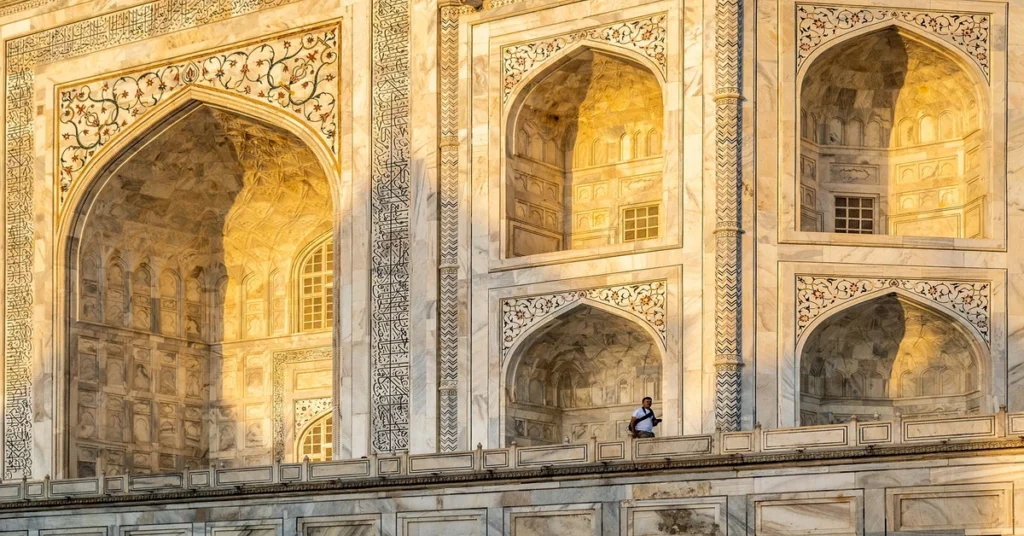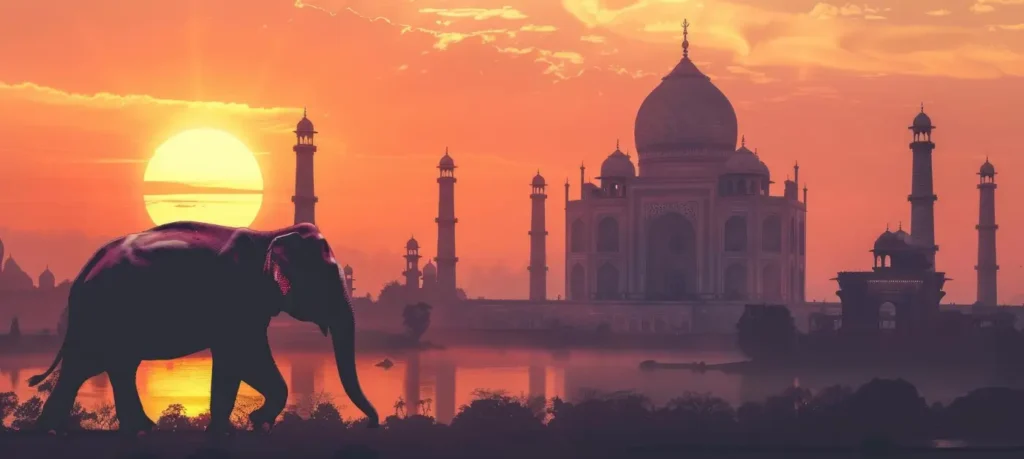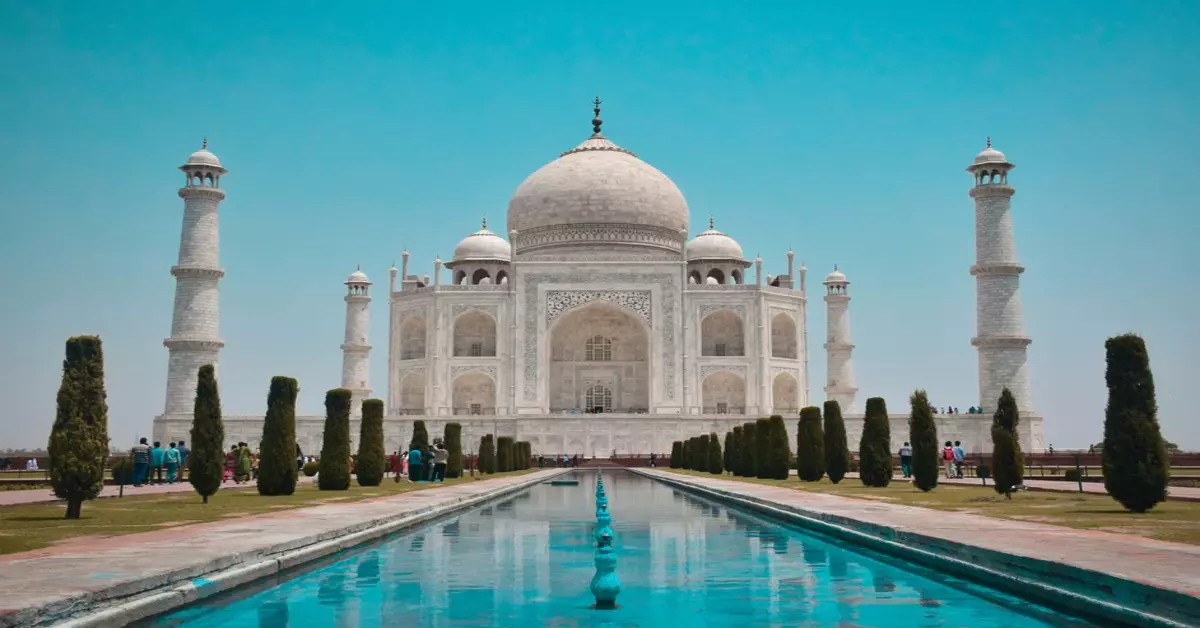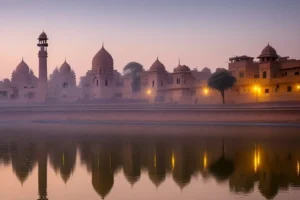The Taj Mahal, situated in Agra, Uttar Pradesh, India, is an epitome of architectural magnificence and a pinnacle of craftsmanship. As per the current literature on History of the Taj Mahal, the monument construction started in the 17th century under the commission of Emperor Shah Jahan. Envisioned as a tribute to Shah Jahan’s beloved wife, Mumtaz Mahal, the Taj Mahal’s creation involved the expertise of artisans from across the Persian, Ottoman, and Indian regions, making it a truly global masterpiece.
Table of Contents
Architectural Marvel: Design and Structure
The Taj Mahal’s captivating beauty lies in its harmonious blend of architectural styles, drawing influences from Islamic, Persian, Ottoman Turkish, and Indian traditions. The monument’s centerpiece is a grand mausoleum made entirely of white marble, emanating an ethereal glow, especially under the soft moonlight. This exquisite marble was meticulously sourced from Makrana in Rajasthan, renowned for its exceptional quality.
Exquisite Inlay Work
The History of the Taj Mahal is adorned with intricate inlay work, a technique known as Pietra Dura. This art form involves embedding precious and semi-precious stones like lapis lazuli, jade, and amethyst into the marble, creating elaborate floral and geometric patterns. This delicate art form exemplifies the exceptional skill and dedication of the artisans who brought Shah Jahan’s vision to life.
Majestic Dome and Minarets telling about History of the Taj Mahal
Another striking feature in the History of the Taj Mahal is its majestic dome, often referred to as an “onion dome.” This impressive structure reaches a height of approximately 35 meters and is crowned with a gilded finial, adding a touch of grandeur. The dome is flanked by four smaller domed kiosks (chattris), creating a sense of perfect symmetry and balance.
Architecture marvel: The Four minarets
The four minarets, strategically positioned at the corners of the platform, serve a dual purpose – being both ornamental and functional. These minarets are slightly tilted outwards, a clever design intended to protect the main mausoleum in case of an earthquake. This innovative approach exemplifies the advanced engineering techniques employed during the Mughal era.

Char Bagh: A Paradise Garden
The layout of the Taj Mahal’s gardens, based on the charbagh concept, reflects the Islamic idea of paradise. This four-part garden is divided by walkways or flowing water, symbolizing the four rivers of paradise. Lush greenery, interspersed with fountains and reflecting pools, creates a serene and tranquil environment, further enhancing the monument’s overall beauty.
A Love Story Etched in Marble: History of the Taj Mahal
The Taj Mahal stands not only as an architectural marvel but also as an enduring testament to the profound love story between Shah Jahan and Mumtaz Mahal. If historians are to be believed, the History of the Taj Mahal mausoleum tells that it was envisioned to honor her memory. Somehow the concept behind this reasoning is questioned many times due to the fact as Mumtaz Mahal died in 1631 during childbirth and historical accounts suggest it was complications arising from a prolonged childbirth of their 14th child, a daughter named Gauhar Ara Begum.
Beyond Architectural Splendor: Cultural Significance
The History of the Taj Mahal emotional resonance extends far beyond its architectural brilliance. For centuries, it has captivated hearts and imaginations worldwide, transcending cultural and geographical boundaries. Visitors are often struck by the poignant love story that inspired its creation, experiencing a deep sense of devotion within its walls. The Taj Mahal is not just a monument to a love story; it’s a universal symbol of enduring love and loss.
A UNESCO World Heritage Site: Marking History of the Taj Mahal
In contemporary times, the Taj Mahal continues to hold immense cultural significance. It is celebrated as a UNESCO World Heritage Site and remains a source of immense national pride for India, attracting millions of visitors each year. The narrative of Shah Jahan and Mumtaz Mahal’s love story has been immortalized in various forms of art, literature, and cinema, further solidifying the Taj Mahal’s status as an emblem of eternal love and a lasting legacy of the Mughal empire.
The Taj Mahal: Preservation Efforts for a Timeless Wonder
The Taj Mahal, a dazzling monument of white marble, has stood the test of time for centuries. However, its enduring beauty requires constant care. This section explores the challenges faced by the Taj Mahal and the ongoing preservation efforts to ensure its legacy for generations to come.
Environmental Threats and Solutions
The History of the Taj Mahal pristine white marble faces a significant threat from pollution caused by industrial emissions and traffic. This has led to discoloration and deterioration. To combat this, the Indian government has implemented the following:
- Taj Trapezium Zone (TTZ): This 10,400 square kilometer zone around the monument aims to control industrial activities and promote cleaner technologies.
Managing Tourist Pressure
The sheer volume of visitors, millions each year, can cause wear and tear on the structure. Measures to mitigate this include:
- Limiting daily visitors
- Designated pathways to manage crowd movement
- Mandatory shoe covers to protect the marble floors

Addressing Natural Aging
Natural aging is inevitable, and the Taj Mahal requires constant restoration to preserve its grandeur. Here’s what’s being done:
- Regular cleaning of marble surfaces using traditional methods
- Repairing cracks and damages
- Foundation reinforcement for stability
Advanced Techniques for Long-Term Protection
Preservation efforts go beyond traditional methods. Here’s how modern technology is playing a role:
- Laser cleaning for delicate cleaning
- Environmental monitoring to track threats
- Advanced restoration materials for improved conservation
International Collaboration for a Global Treasure
The Taj Mahal’s preservation is a global effort. Collaborative initiatives involve:
- International experts
- Heritage organizations
These collaborations ensure the monument’s long-term protection for future generations.
Planning Your Visit to the Taj Mahal: Experience the History of the Taj Mahal
The Taj Mahal beckons travelers worldwide. Here are some tips for planning your visit:
Finding the Perfect Time
- October to March: Enjoy pleasant weather and clear skies for stunning photos.
Essential Tips for a Seamless Visit
- Security checks: Be prepared for thorough security checks.
- Book tickets in advance: Avoid long queues, especially during peak season.
- Opening hours: Sunrise to sunset. Consider dawn or dusk for mesmerizing views.
- Guides: Hire a knowledgeable guide for deeper historical and cultural insights.
- Footwear: Wear comfortable shoes, as footwear needs to be removed before entering the main mausoleum.
- Prohibited items: Food, tobacco, and large bags are not allowed.
Exploring Agra Beyond the Taj Mahal
Agra offers more than just the Taj Mahal:
- Agra Fort (UNESCO World Heritage Site): Experience Mughal era opulence.
- Mehtab Bagh gardens: Enjoy serene views of the Taj Mahal across the Yamuna River.
- Local Culture: Immerse yourself in Agra’s warm hospitality, savor Mughlai cuisine, and shop for handicrafts.
A visit to the Taj Mahal is a journey through time and culture. With careful planning, you can experience the timeless beauty and rich history of this iconic monument.
FAQs About the History of the Taj Mahal and Now
Where is the Taj Mahal located?
The Taj Mahal is situated in Agra, India, a city in the state of Uttar Pradesh.
Why was the Taj Mahal built?
The Taj Mahal was commissioned by Mughal emperor Shah Jahan in memory of his third wife, Mumtaz Mahal, who died during childbirth. It serves as a magnificent mausoleum and a testament to their love story.
What is the Taj Mahal made of?
The Taj Mahal’s primary material is white marble, sourced from Makrana in Rajasthan, India. It also features intricate inlay work with precious and semi-precious stones like lapis lazuli, jade, and carnelian.
When was the Taj Mahal built?
Construction of the Taj Mahal commenced in 1632 and was completed in 1653, spanning over two decades.
What is the architectural style of the Taj Mahal?
The Taj Mahal showcases a harmonious blend of architectural influences, including Islamic, Persian, Ottoman Turkish, and Indian styles. This fusion creates a stunning and symmetrical structure.
Is the Taj Mahal really white?
The Taj Mahal appears white under most lighting conditions. However, due to the use of translucent marble, the monument can take on different hues depending on the time of day and the surrounding light.
What are some interesting features of the Taj Mahal?
The Taj Mahal boasts several notable features, including its majestic dome, four minarets, intricate inlay work (Pietra Dura), and the charbagh, a four-part garden symbolizing paradise.
Is the Taj Mahal a UNESCO World Heritage Site?
Yes, the Taj Mahal was designated a UNESCO World Heritage Site in 1983, recognizing its exceptional cultural and historical significance.
Can you still visit the Taj Mahal today?
Absolutely! The Taj Mahal remains a popular tourist destination, welcoming millions of visitors each year. It’s open from sunrise to sunset.
Are there any myths or legends surrounding the Taj Mahal?
Yes, several myths and legends exist, such as the story of a “Black Taj Mahal” or the mutilation of artisans. However, historical evidence does not support these tales.





